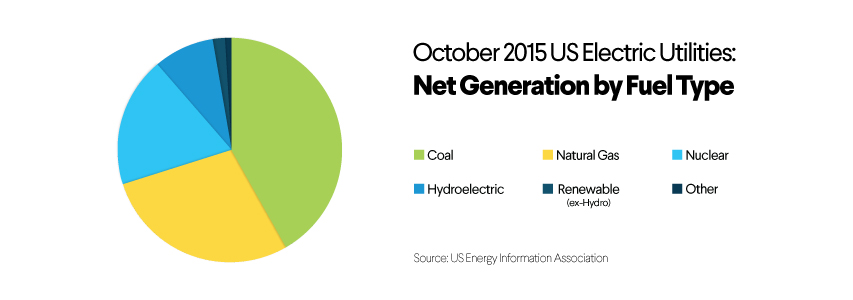How to Go Green With Solar Energy in a House or Apartment
Maybe you have long been on the recycling bandwagon, you eat seasonal and local foods, perhaps you even buy carbon offset credits to reduce your carbon footprint. But now you want to take the next step and go green with your energy usage, as well.
Whether you own a house or rent an apartment, there are several great options available for adopting renewable energy these days. Here’s a quick guide to the basic options – including what the costs look like and what benefits you may gain as a result.
First, consider: Where does your energy come from now?
Like most of the United States, you are probably powering up your electricity by paying a traditional utility company for power sourced from “the grid.” A variety of sources fuel the grid, as you can see in the chart below.
It’s clear that traditional electricity is largely powered by pollutant and exhaustible fossil fuels. This is both a) unsustainable for our species’ ever-growing power demand and b) terrible for the environment.
Source: US Energy Information Association
What are your green home options?
If you live in a house:
As a homeowner you can have solar panels installed on your rooftop and tap into the power of solar energy directly. For an average-sized home, buying solar panels will set you back around $25,000. However, at tax time you can claim a 30% renewable energy tax credit provided by the federal government. This credit is being phased out and will start to decrease as early as 2019 – so if you’re going to make the investment, you may want to do it sooner rather than later.
Another benefit that offsets the cost is the savings you’ll enjoy on your energy bill over the long-term. The exact amount of savings varies for each household based on a few factors, but you can use an online calculator like Google’s Project Sunroof to estimate what your savings would be.
If you don’t have the cash to spare or would rather put that capital to work elsewhere, you can finance the purchase of solar panels using a personal loan. The better your financial situation and history of managing debt, the lower your rate will likely be. Between the tax credit and the cost savings, solar financing with a personal loan can be an attractive option.
As an example, I used Project Sunroof to calculate the 20-year cost savings for my friend’s average-sized home in Oakland, CA. Without solar panels, his monthly electricity bill is about $175/month, which with an annual 2.2% increase (Project Sunroof’s default, and a conservative estimate based on historical growth and future expectations) would end up costing him $52,579 over 20 years. Here’s how he would make out using a $25,000, 5-year, 7% fixed rate personal loan to install a 405 square foot (5.75 kwz) solar panel instead:
Total 20-year energy cost with solar panels: $23,935
Total interest cost of 5-year, 7% personal loan: $4,702
Total savings: $23,942
And that doesn’t include the potential tax credit mentioned above, which could increase your savings even more.
For the apartment dweller:
If you live in an apartment, solar panels are usually not an option (unless you can convince the landlord it’s a good idea). Luckily there are other ways to reap the benefits of solar energy, usually in the form of “shared renewables.” They can be structured in one of two ways:
– Solar Renewable Energy Credits (SRECs) — Some utility companies offer the option of purchasing energy from a renewable energy source or will provide a monthly credit to someone who chooses to invest in a solar farm elsewhere – check with your utility company to see what they can do.
– Community Solar — In this case, a group of individuals or donors set up a legal entity that invests in the development of a solar farm for the use of a local community of consumers. These projects are often located on public or jointly-owned property, and provide a way for renters and condominium owners to benefit from a local solar energy project. The Solar Energy Industries Association provides more info on how to tap into these projects.
Power in Numbers
If you own a house and have the cash available to purchase solar installation outright, you should see your investment pay off in just a few years’ time. And if you don’t want to put up so much cash upfront, a home improvement loan can be a great option for you – and should still allow you to enjoy the savings benefit over time.
Regardless of whether you are a homeowner or apartment dweller, you can go green at home and do your part to help clean up our planet. And this all comes with the added bonus of saving money at the same time – now that’s what you call a win/win.







Solar energy is a clean and renewable energy source and it cannot cause pollution. No problems and very happy that we chose solar panel for our home.